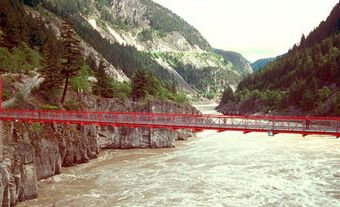Water Distribution System
Water Distribution System, a provincially regulated network used to distribute water from a central location to a location of end use. While the most complex distribution systems are those required to supply urban areas, fairly extensive systems are also used in some areas to supply irrigation water to orchards and to vegetables and other crops. Elaborate distribution systems may also be required within a major industrial plant (eg, steel mill, petroleum refinery) or commercial complex (eg, large shopping centre, office building).
Nearly 80% of Canada's population is classifed as "urban," and the distribution of water to this group of users is a major task. Most of Canada's larger cities are located on or near a major river system or lake, which provides water for distribution. Since river systems extend across provincial, territorial or national boundaries, some degree of intergovernmental co-operation is required in water management; for example MACKENZIE RIVER Basin Committee, Prairie Provinces Water Board, and International St Croix River Board of Control. Some cities obtain their water from a relatively distant but more reliable source (for example, Winnipeg's water comes via aqueduct from Lake of the Woods, 150 km away); groundwater supplies the needs of other cities, notably Kitchener-Waterloo.
Canadian cities developed urban water distribution systems quite early: Toronto and Kingston had pumping stations by 1841 and 1850, respectively; gravity systems were operating even earlier in Saint John, NB, and Halifax, NS, in 1838 and 1848. By the 1870s, the water supplies of most large cities were steam pumped. Although the amount of water used for fire protection is small compared to other uses, the high rate of water flow needed in fire fighting is often the most important factor to be considered in designing the system. The system's main components are pumping stations to create and maintain pressure, reservoirs to store water and aid in pressure equalization, and a network of pipes to convey the water to users.
Distribution systems for farm IRRIGATION typically consist of a network of canals or pipes. With pipe systems, pumps are used to maintain sufficient hydraulic head to operate spray irrigation equipment, and valves are used to control flow in the pipes. With canal systems, a combination of gravity, pumps, weirs and gates are used to distribute and control the flow of water through the system. In Canada the Prairie provinces have the largest area under irrigation, 559 954 ha; British Columbia is next with 117 811 ha; the rest of Canada has 29 860 ha of irrigated land. Irrigation systems may be privately developed or may be put in place with the assistance of provincial or federal governments (see PRAIRIE FARM REHABILITATION ADMINISTRATION).
Before the environmental movement of the late 1960s, water agencies built more and larger dams and conveyance facilities to meet the demand for water; but rising costs and growing public opposition to such projects forced planners to explore other means of supplying the demand. Most solutions are aimed at efficient use of water, since waste is a major problem. Canada's per capita water-use rates are among the world's highest. Research shows that economic pricing and conservation can save impressive quantities of water. The Federal Water Policy (1987) endorsed user fees to regulate water demand and production costs. The policy also prohibited large-scale export as a threat to the environment and to Canada's future needs.

 Share on Facebook
Share on Facebook Share on X
Share on X Share by Email
Share by Email Share on Google Classroom
Share on Google Classroom


